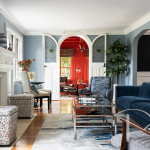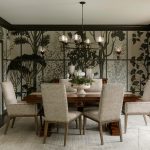The Real Cost of Design: Why Professional Guidance Saves More than Money
A few years ago, I walked into an initial consultation with a couple who loved to host. Their extended family gathered often, but their small, formal dining room couldn’t accommodate the twelve or more people they regularly entertained.
The husband—an engineer by trade—had already drafted plans. He explained in detail how they could expand the opening between the formal living and dining rooms, reconfigure the hardwoods and entry tile to a single level, and then rotate the dining table 90 degrees for family gatherings. It was logical, technical, and costly. Contractors had even provided estimates: around $8,000 for the work.
After listening carefully, I asked a simple question: “Why don’t we turn the unused formal living room into the dining room? Your table leaves can stay in full time, there’s room for everyone without moving a thing, and the original dining room can become a cozy sitting space for reading and intimate conversation.”
There was a long pause. Then he said, “Wow. You just saved me $8,000.”
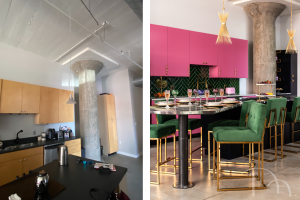
From drab to dreamy! Extending the island for more seating, painting the cabinets for drama, and adding a luscious countertop ticked all the boxes for this couple./Photo by Karen Palmer
Design Is More Than Problem-Solving
That moment illustrates something essential about professional design: it isn’t just about making a space look beautiful. It’s about seeing possibilities that homeowners, contractors, and even engineers often overlook.
The couple had been so focused on solving the problem with construction—demo, rework, rebuild—that they hadn’t considered a simpler solution hiding in plain sight. By reframing how the existing square footage was used, they not only saved thousands of dollars but also gained a layout that worked better every single day.
This is what professional design does. It looks past the obvious fixes to find solutions that are smarter, simpler, and often far less expensive.
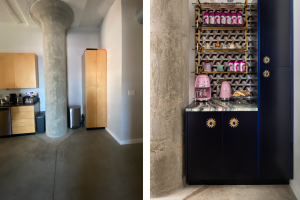
By incorporating the wasted space next to the cabinets, we were able to create an over-the-top tea and coffee bar with added upright storage to the right./Photo by Karen Palmer
The Hidden Costs of Being Your Own Designer
When homeowners attempt design solutions without professional guidance, the fixes often feel bigger than they need to be. Walls get moved, custom pieces are ordered, or expensive finishes are installed, yet the underlying problem still lingers. Other times, the mistakes are less dramatic but just as costly. A sofa that looked perfectly scaled in a cavernous showroom suddenly overwhelms a standard living room. A dining table feels too small once guests are seated, or too large for daily use. Chairs and casegoods that seemed sturdy enough reveal poor construction after only a few months of real life.
We’ve seen kitchens redone at enormous expense because the original layout never supported the way the family lived. We’ve walked into homes with five-figure lighting plans that left rooms feeling cold and clinical. And just as often, we’ve met clients surrounded by furnishings that were all individually “beautiful,” but completely wrong for their space—oversized, underbuilt, or simply out of sync with the home’s proportions and the family’s lifestyle.
The common thread in all of these stories is the same: money was spent, but the results didn’t deliver. Without design expertise to guide those choices, the investment works against you instead of for you.
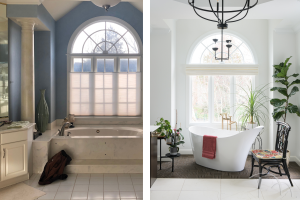
We highlighted the tub area by using a contrasting porcelain tile made to look like wood parquet flooring, and angled the tub for bird watching while bathing./Photo by Karen Palmer
___________________________
Smarter Spending, Better Living
The dining room story proves that good design isn’t always about adding more square footage or investing in bigger, costlier moves. Sometimes it’s about looking at what you already have and using it more intelligently. In that case, a simple switch of purpose between two rooms created a dining space that could host the entire family and a cozy sitting area that enriched daily life. No walls needed to come down. No tile needed to be replaced. No contractor bids were necessary.
This same principle applies to every project we touch. Rethinking circulation paths can transform how a home feels without changing its footprint. Considering how storage is used can make clutter disappear and routines flow with ease. Designing lighting for both mood and function can completely change how a room is experienced, from the energy of a lively gathering to the quiet calm of an evening at home. And most importantly, anticipating how a space will actually be lived in prevents costly missteps before they ever happen.
Professional design fees often represent 10 to 15 percent of a project’s cost, but the mistakes we prevent routinely add up to 20 or 30 percent—or more. Beyond the numbers, though, the return is felt every single day. A kitchen that makes cooking joyful, a bathroom that feels like a spa retreat, and a living room that finally invites conversation are all examples of design that goes beyond aesthetics to improve daily life in tangible ways.
___________________________
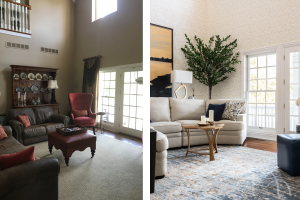
How to fit furniture into a room with only one wall? Purchase an angled sectional and angle it some more so all seats have a great view and the room feels cozy/comfy./Photo by Karen Palmer
___________________________
The Real Value of a Designer
The husband in that consultation didn’t just save $8,000. He gained peace of mind. He saw that there was another way to approach his home—one that protected his investment while enhancing how his family lived.
That’s the true value of professional design. We don’t just create beautiful rooms; we make sure every dollar you spend is working as hard as it can. We uncover solutions that are elegant, efficient, and intentional, so your home becomes not just more beautiful but more livable.
Because the most expensive design mistake isn’t the one you notice immediately. It’s the one that could have been prevented from the start.
Ready to see what possibilities might be hiding in your own home? Let’s design something beautiful—and smart—together.
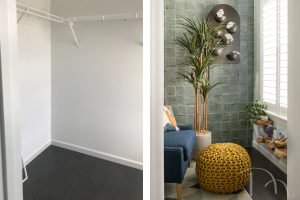
An unused closet with a window is the perfect spot for meditation. A wall-mounted water fountain, faux palm, and tiled wall create the perfect oasis of calm./Photo by Karen Palmer
___________________________


